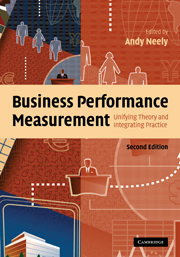Book contents
- Frontmatter
- Contents
- List of figures
- List of tables
- List of boxes
- List of contributors
- Introduction
- Part I Performance measurement – functional analyses and theoretical foundations
- Part II Performance measurement – frameworks and methodologies
- 7 Performance measurement frameworks: a review
- 8 Beyond budgeting to the adaptive organization
- 9 Theoretical conditions for validity in accounting performance measurement
- 10 The validity of measurement frameworks: measurement theory
- Part III Performance measurement – practicalities and challenges
- Part IV Performance measurement in public services
- Part V Performance measurement – emerging issues and enduring questions
- Index
- References
10 - The validity of measurement frameworks: measurement theory
Published online by Cambridge University Press: 22 September 2009
- Frontmatter
- Contents
- List of figures
- List of tables
- List of boxes
- List of contributors
- Introduction
- Part I Performance measurement – functional analyses and theoretical foundations
- Part II Performance measurement – frameworks and methodologies
- 7 Performance measurement frameworks: a review
- 8 Beyond budgeting to the adaptive organization
- 9 Theoretical conditions for validity in accounting performance measurement
- 10 The validity of measurement frameworks: measurement theory
- Part III Performance measurement – practicalities and challenges
- Part IV Performance measurement in public services
- Part V Performance measurement – emerging issues and enduring questions
- Index
- References
Summary
Introduction
When considering measurement, the first practical questions faced by managers should be: what is it that requires measurement, and what is measurement? Answering these two questions at something more than a superficial level can take managers a long way towards the design and development of a measurements system suited to their needs.
One surprising issue often overlooked when measuring systems are designed concerns the nature and purpose of the measurement. Quite often this is brutally exposed by the chief executive if, when presented with new results for the first time, he or she says “So what?”. A considerable benchmarking industry has grown up around the subject of performance measurement. Performance measurement assumes that the results it provides and the benchmarking activities that accompany it are useful in themselves. The motivation of the chief executive in the statement above is to question value – that is, how valuable this performance is to the company. Would it make a difference to any of his/her stakeholders or shareholders if the performance of certain factors were to increase by 10 per cent or if they were to decline by 10 per cent? The distinction between value and performance is critical, and, in general, performance measurement should be seen only as the first step on the way to providing useful value-based output. Measuring value adds some particular difficulties, especially with the definition of value, and involves the axiology of the individual.
Information
- Type
- Chapter
- Information
- Business Performance MeasurementUnifying Theory and Integrating Practice, pp. 218 - 236Publisher: Cambridge University PressPrint publication year: 2007
References
Accessibility standard: Unknown
Why this information is here
This section outlines the accessibility features of this content - including support for screen readers, full keyboard navigation and high-contrast display options. This may not be relevant for you.Accessibility Information
- 7
- Cited by
